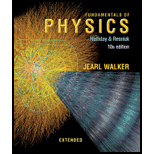
Concept explainers
Figure 25-18 shows plots of charge versus potential difference for three parallel-plate capacitors that have the plate areas and separations given in the table. Which plot goes with which capacitor?
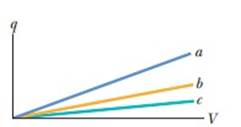
Figure 25-18 Question 1.
| Capacitor | Area | Separation |
| 1 | A | d |
| 2 | 2A | d |
| 3 | A | 2d |
To find:
Which plot goes with which capacitor.
Answer to Problem 1Q
Solution:
Plot a goes with the capacitor 2. The plot b goes with capacitor 1 and plot c goes with capacitor 3.
Explanation of Solution
1) Concept:
Using Eq.25-9, we can find capacitance of each capacitor from the given values of area and plate separation. Then using Eq.25-1, we can compare the capacitance from the slopes of the plots. Then, comparing the predictions about the capacitance yielded from both the equations, we can find out which plot goes with which capacitor.
2) Formulae:
i) From Eq.25-1, the charge
ii) From Eq.25-9, the capacitance is
3) Given:
i) For capacitor 1, area is
ii) For capacitor 2, area is
iii) For capacitor 3, area is
iv) For capacitor 1, separation is
v) For capacitor 2, separation is
vi) For capacitor 3, separation is
4) Calculations:
From Eq.25-1, the charge
where
Therefore, the capacitance is given by
From Eq.25-9, the capacitance is
where
Let,
Capacitor 1 has capacitance,
Similarly, Capacitor 2 has capacitance,
And Capacitor 3 has capacitance,
From this, we can interpret that capacitance of capacitor 2 has the greatest value and capacitor 1 has the greater capacitance than that of capacitor 3.
From the graph, we can infer that the plot a has the greatest slope. Hence, the capacitance and the slope of plot b is greater than that of plot c. Hence, corresponding capacitance.
Therefore, we can conclude that, Plot a goes with capacitor 2, plot b goes with capacitor 1 and plot c goes with capacitor 3.
Conclusion:
We can predict about the plots between the charge and the voltage corresponding to capacitors having some area and separation between the plates of capacitor from the slope of the graph and the formula for capacitance.
Want to see more full solutions like this?
Chapter 25 Solutions
Fundamentals of Physics Extended
Additional Science Textbook Solutions
Tutorials in Introductory Physics
Conceptual Physics (12th Edition)
Mathematical Methods in the Physical Sciences
The Cosmic Perspective
Physics: Principles with Applications
An Introduction to Thermal Physics
- (i) Rank the following five capacitors from greatest to smallest capacitance, noting any cases of equality, (a) a 20-F capacitor with a 4-V potential difference between its plates (b) a 30-F capacitor with charges of magnitude 90 C on each plate (c) a capacitor with charges of magnitude 80 C on its plates, differing by 2 V in potential. (d) a 10-F capacitor storing energy 125 J (e) a capacitor storing energy 250 J with a 10-V potential difference (ii) Rank the same capacitors in part (i) from largest to smallest according to the potential difference between the plates, (iii) Rank the capacitors in part (i) in the order of the magnitudes of the charges on their plates, (iv) Rank the capacitors in part (i) in the order of the energy they store.arrow_forward(a) Regarding (lie Earth and a cloud layer 800 m above the Earth as the plates of a capacitor, calculate the capacitance of the Earth-cloud layer system. Assume the cloud layer has an area of 1.00 km2 and the air between the cloud and the ground is pure and dry'. Assume charge builds up on the cloud and on the ground until a uniform electric field of 3.00 106 N/C throughout the space between them makes the air break down and conduct electricity as a lightning bolt, (b) What is the maximum charge the cloud can hold?arrow_forward(a) Find the equivalent capacitance between points a and b for the group of capacitors connected as shown in Figure P25.12 (page 686). Take C1 = 5.00 F, C2 = 10.0 F, and C3 = 2.00 F. (b) What charge is stored on C3 if the potential difference between points a and b is 60.0 V? Figure P25.12arrow_forward
- What If? The two capacitors of Problem 13 (C1 = 5.00 F and C2 = 12.0 F) are now connected in series and to a 9.00-Y battery. Find (a) the equivalent capacitance of the combination. (b) the potential difference across each capacitor, and (c) the charge on each capacitor.arrow_forwardAn arrangement of capacitors is shown in Figure P27.23. a. If C = 9.70 105 F, what is the equivalent capacitance between points a and b? b. A battery with a potential difference of 12.00 V is connected to a capacitor with the equivalent capacitance. What is the energy stored by this capacitor? Figure P27.23 Problems 23 and 24.arrow_forwardFour capacitors are connected as shown in Figure P20.45. (a) Find the equivalent capacitance between points a and b. (b) Calculate the charge on each capacitor, taking Vab = 15.0 V. Figure P20.45arrow_forward
- The dielectric to be used in a parallel-plate capacitor has a dielectric constant of 3.60 and a dielectric strength of 1.60107 V/m. The capacitor has to have a capacitance of 1.25 nF and must be able to withstand a maximum potential difference 5.5 kV. What is the minimum area the plates of the capacitor may have?arrow_forward(a) Find the equivalent capacitance between points a and b for the group of capacitors connected as shown in Figure P20.44. Take C1 = 5.00 F, C2 = 10.0 F, and C3 = 2.00 F. (b) What charge is stored on C3 if the potential difference between points a and b is 60.0 V? Figure P20.44arrow_forward(i) A battery is attached to several different capacitors connected in parallel. Which of the following statements is true? (a) All capacitors have the same charge, and the equivalent capacitance is greater than the capacitance of any of the capacitors in the group, (b) The capacitor with the largest capacitance carries the smallest charge, (c) The potential difference across each capacitor is the same, and the equivalent capacitance is greater than any of the capacitors in the group. (d) The capacitor with the smallest capacitance carries the largest charge. (e) The potential differences across the capacitors are the same only if the capacitances are the same, (ii) The capacitors are reconnected in series, and the combination is again connected to the battery. From the same choices, choose the one that is true.arrow_forward
- A spherical capacitor consists of a spherical conducting shell of radius b and charge 2Q that is concentric with a smaller conducting sphere of radius a and charge +Q (Fig. P20.36). (a) Show that its capacitance is C=abke(ba) (b) Show that as b approaches infinity, the capacitance approaches the value a/ke = 40a. Figure P20.36arrow_forward(a) Find the equivalent capacitance between points a and b for the group of capacitors connected as shown in Figure P16.46 if C1 = 5.00 F, C2 = 10.00 F, and C3 = 2.00 F. (b) If the potential between points a and b is 60.0 V, what charge is stored on C5? Figure P16.46arrow_forwardGiven the arrangement of capacitors in Figure P27.23, find an expression for the equivalent capacitance between points a and b. Figure P27.23 Problems 23 and 24.arrow_forward
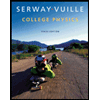 College PhysicsPhysicsISBN:9781285737027Author:Raymond A. Serway, Chris VuillePublisher:Cengage Learning
College PhysicsPhysicsISBN:9781285737027Author:Raymond A. Serway, Chris VuillePublisher:Cengage Learning Physics for Scientists and Engineers: Foundations...PhysicsISBN:9781133939146Author:Katz, Debora M.Publisher:Cengage Learning
Physics for Scientists and Engineers: Foundations...PhysicsISBN:9781133939146Author:Katz, Debora M.Publisher:Cengage Learning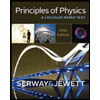 Principles of Physics: A Calculus-Based TextPhysicsISBN:9781133104261Author:Raymond A. Serway, John W. JewettPublisher:Cengage Learning
Principles of Physics: A Calculus-Based TextPhysicsISBN:9781133104261Author:Raymond A. Serway, John W. JewettPublisher:Cengage Learning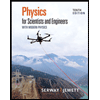 Physics for Scientists and Engineers with Modern ...PhysicsISBN:9781337553292Author:Raymond A. Serway, John W. JewettPublisher:Cengage Learning
Physics for Scientists and Engineers with Modern ...PhysicsISBN:9781337553292Author:Raymond A. Serway, John W. JewettPublisher:Cengage Learning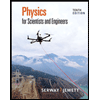 Physics for Scientists and EngineersPhysicsISBN:9781337553278Author:Raymond A. Serway, John W. JewettPublisher:Cengage Learning
Physics for Scientists and EngineersPhysicsISBN:9781337553278Author:Raymond A. Serway, John W. JewettPublisher:Cengage Learning College PhysicsPhysicsISBN:9781305952300Author:Raymond A. Serway, Chris VuillePublisher:Cengage Learning
College PhysicsPhysicsISBN:9781305952300Author:Raymond A. Serway, Chris VuillePublisher:Cengage Learning





